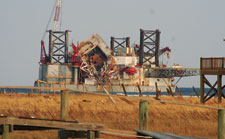 |
Hurricane Katrinas devastating blow to one of the nations largest energy hubs on Aug. 29 nearly shut down crude-oil and natural-gas production in the Gulf of Mexico. It also significantly reduced refining capacity, resulting in a 50% hike in gas prices in some parts of the country.
Nearly 75% of the Gulfs production platforms and 96 of its 137 drilling rigs were evacuated ahead of Katrina, the U.S. Minerals Management Service reports. The storms impact created gas lines reminiscent of the 1973-74 energy crisis caused by the Arab oil embargo.
 |
| Crash Landing. Platform took a direct hit on topside. (Photo by Michael Powers for ENR) |
In response, the Environmental Protection Agency waived summer volatility fuel standards requiring a lower Reid Vapor Pressure. EPA also allowed diesel fuel exceeding 500-ppm sulfur content to be used. The Treasury Dept. and Internal Revenue Service said that "dyed diesel fuel" would be permitted for on-road use to bring more diesel supply into the market. And the Dept. of Homeland Security waived Jones Act restrictions on foreign-flag tankers and barges, allowing oil and gas supplies to be carried into ports that have seen supply disruptions from pipelines running at lower capacity.
Katrina shut down almost 92% of the Gulfs typical 1.5-million-bbl/day crude production, and 83% of its normal 10 billion-cu-ft-per-day gas output, the U.S. Minerals Management Service says.
President Bush on Aug. 31 announced emergency loans of crude from the 727-million-bbl Strategic Petroleum Reserve to help refiners in the wake of Katrinas damage. The "short-term" loans must be returned "once supply conditions return to normal," says Energy Secretary Samuel Bodman. DOE netted 234,000 bbl in sweet-crude interest from 5.4-million-bbl of post-Hurricane Ivan loans. They carried 1.8 to 5.6% premiums.
But Gulf operators remain cautiously upbeat. Initial assessments found serious damage to only four deepwater platforms, with just 27 of the 6,500 production facilities suffering damage or destruction, says Red Cavaney, president of the American Petroleum Institute, a Washington D.C.-based trade group. BP says it lost seven smaller production platforms in the West Delta and Grand Isle areas of the Gulf; Apache lost eight production platforms; Noble Energy lost one platform; Newfield Exploration lost one; and Shells deepwater Mars Platform, which produces 147,000 bbl per day of crude and 157-million cu ft per day of gas, sustained topside damage, Cavaney says.
|
Petroleos Mexicanos 13,000-ton PSS Chemul semisubmersible rig was swept off a dry-dock barge in Alabama on the morning of Aug. 29 and carried a mile upstream against the current before slamming into the Cochrane-Africatown U.S.A. Bridge along U.S. 98 in Mobile County, Ala. The rig was at the Bender Shipbuilding & Repair Co. Inc., Mobile, for routine maintenance and repair when the accident happened. The bridge, Alabamas only cable-stayed span, reopened Aug. 30 after state engineers found no significant structural damage.
Roughly 2.35-million bbl per day of U.S. Gulf Coast refining capacity, more than 25% of the regions capacity, had been idled as a result of Katrina. But refineries are slowly staggering back to life. Shell returned the 232,000-bbl-per-day Motiva refinery at Convent, La., to service on Sept. 4; Marathon Oil restarted its 245,000-bbl-per-day plant at Garyville, La., on Sept. 5, and ExxonMobil planned to ramp throughput to maximum rates at its 493,000-bbl-per-day Baton Rouge refinery by late Sept. 5. Valero said that with power restored and recovery crews in place at its 155,000-bbl-per-day St. Charles, La., refinery, that plant could resume service in several days. On Sept. 5, BP said its deepwater Holstein SPAR facility returned to service, producing 70,000 bbl, and its Caesar and Cleopatra pipelines resumed service as well.
But the prospects for restarting three other large plants with a total capacity of 700,000 bbl per day remained cloudy at best. Observers say it could take months to get some of those facilities on line.

Post a comment to this article
Report Abusive Comment